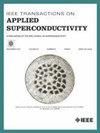一种有效模拟无绝缘高温超导线圈充电特性和损耗的场路耦合模型
IF 1.8
3区 物理与天体物理
Q3 ENGINEERING, ELECTRICAL & ELECTRONIC
引用次数: 0
摘要
无绝缘(NI)高温超导体(HTS)线圈引入了匝间电路径,增强了它们的热稳定性和抗淬火的自我保护能力。然而,额外的匝间电路径使高温超导线圈的几何和物理建模复杂化。本文提出了一种场路耦合模型,其中HTS分量被视为电路模型中包含电阻电压和感应电压的全局电压参数。电路模型中的超导支路电流作为NI高温超导线圈的外部电流输入。有限元方法模型基于$\mathbf {J}$ - $\mathbf {A}$公式控制的各向异性电阻率模型,考虑了过临界电流状态下涂层导体中金属层的电流共享效应。为了全面验证所提出的模型,说明了两个关键特性:首先,比较了突然放电、充电和过临界电流状态的实验测量数据;第二,比较计算效率与流行的$\mathbf {H}$-公式模型。结果表明,计算结果与实验结果吻合较好,验证了所提模型的有效性和适用性。与$\mathbf {H}$-公式模型相比,该模型在不牺牲计算精度的情况下,计算效率提高了82%以上。此外,根据所提出的模型,发现在过临界电流状态下,金属层的电流共享效应可以忽略不计。为了验证所提出模型的更广泛适用性,我们模拟了用磁通泵给闭环NI HTS线圈充电。该模型能较好地表征电压源激励特性,分析充电时间常数的频率饱和。在此基础上,我们进一步研究了不同行波频率下的超导电阻损耗和匝间损耗。本文章由计算机程序翻译,如有差异,请以英文原文为准。
A Field-Circuit Coupled Model for Efficiently Simulating the Charging Characteristics and Losses in No-Insulation HTS Coils
No-insulation (NI) high-temperature superconductor (HTS) coils introduce turn-to-turn electrical paths, enhancing their thermal stability and self-protection capacity against quenching. However, the extra turn-to-turn electrical paths complicate both the geometrical and physical modeling of HTS coils. This article presents a field-circuit coupled model where the HTS component is treated as a global voltage parameter that contains resistive and inductive voltage in the circuit model. The superconducting branch current in the circuit model serves as external current input to the NI HTS coil. The finite element method model is based on an anisotropic resistivity model governed by the $\mathbf {J}$ $\mathbf {A}$ $\mathbf {H}$ $\mathbf {H}$
求助全文
通过发布文献求助,成功后即可免费获取论文全文。
去求助
来源期刊

IEEE Transactions on Applied Superconductivity
工程技术-工程:电子与电气
CiteScore
3.50
自引率
33.30%
发文量
650
审稿时长
2.3 months
期刊介绍:
IEEE Transactions on Applied Superconductivity (TAS) contains articles on the applications of superconductivity and other relevant technology. Electronic applications include analog and digital circuits employing thin films and active devices such as Josephson junctions. Large scale applications include magnets for power applications such as motors and generators, for magnetic resonance, for accelerators, and cable applications such as power transmission.
 求助内容:
求助内容: 应助结果提醒方式:
应助结果提醒方式:


